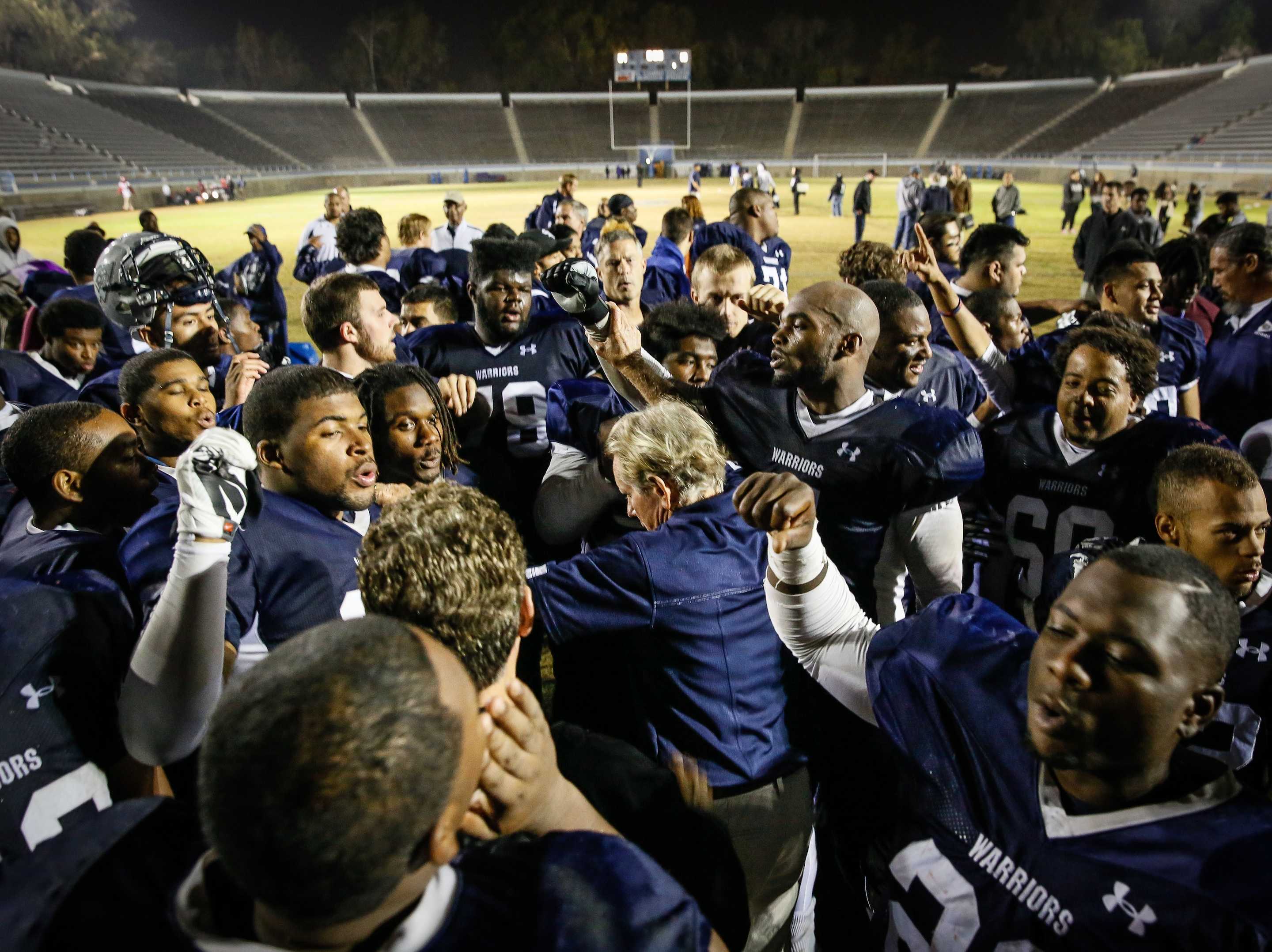Touchdown in a new city
May 6, 2014
Every fall, El Camino students watch football games with friends and with family, but most never think about where the players come from. Some come from 3,000 miles away to play for our team, one of the best in the state.
“I never thought in a million years I’d be playing football in California,” sophomore linebacker Nikorey Benyard said.
Originally from Miami, the 6-foot-3-inch 210 pound Benyard thought he would go to a Division 1 school after graduating from Miami Springs High School, but he ended up going to the University of South Dakota.
He was looking to leave that college, so he began getting in contact with EC’s coaches and moved to California and started attending EC in spring 2012, Benyard said.
Another player on the team, sophomore defensive lineman Trayvis Peters, came to EC last spring from Miami.
The process to get athletes to play football at EC from out of state has been ongoing for decades. Coach John Featherstone and assistant coach Gene Engle started bringing in players from out of state in the ‘90s.
“I’d say probably for the first 10 years that we were here, coach Engle and I, we just went with local kids,” Featherstone said.
Local kids were, and still are, from Bishop Montgomery, El Segundo, Hawthorne, Inglewood, Junipero Serra, Lawndale, Leuzinger, Mira Costa, Morningside, North Torrance, Palos Verdes, Peninsula, Redondo Union, St. Bernard’s, South Torrance, Torrance, and West Torrance high schools, Featherstone said.
Most of the out-of-state players on the roster last fall were from Florida, usually from the Miami area. Featherstone said this is because the first group of Florida kids came from Miami and EC’s name spread like wildfire in the Miami school district.
The first player to play football at El Camino from out of state was from Miami. He played at El Camino, then returned to Miami and played at the University of Miami, Engle said.
“If one person does well, then the word gets back and there was a stream of kids who would contact us and they came out,” Engle said. “(People hear about EC) by word of mouth. And then it’s publicized. People look online at successful programs in California. We’re one of the more successful programs in California.”
EC remains the community college with the highest winning percentage in the 37 junior colleges from Bakersfield to San Diego under Featherstone’s direction, as he’s been the coach for 29 years.
“You get word of mouth, you get publicity, and then you get ranking,” Engle said. “I think those are the things that drive people to initially reach out and contact us.”
Engle said one of the main reasons players come from Florida is because the junior colleges in Florida don’t have football. They have other sports, but not football. This leaves Florida high school football players looking to four year universities in Florida and elsewhere, or at junior colleges in other states to continue playing.
“Ten years ago, 12 years ago, (kids in Miami) didn’t know anything about California. But now everybody knows everything,” Featherstone said. “They know about the JC system. They know which JC programs are the best. And we’re definitely one of the best.”
Featherstone said it’s illegal for coaches to leave the state to view potential players, so they view the players on film.
The coaches do this via Hudl, a “nationwide scouting service kind of thing,” Engle said. Players’ statistics along with videos of them are available to recruiters.
These videos tell coaches around the nation a lot and gives them an idea of how they play.
“We can kind of get a feel of how they rate with some of the guys we have now,” Featherstone said.
Engle said the coaches are contacted all the time, and that’s only increased with the explosion of the Internet. He said out-of-state schools and athletes contact every junior college in California by sending out mass emails.
“I would probably spend two hours a day if I looked at every film of every kid that contacted us,” Engle said. “We are bombarded daily by 30 or 40 kids from Florida, from Alabama, from back in New Jersey, wanting to come out here and play.”
Recruitment, from out-of-state to EC and EC to four-year universities, is a busy process.
“It’s like Baskin Robbins. Take a number,” Featherstone said.
Still, it’s hard for young adults to move far from everything they knew.
“It’s hard for them to compete. They think it’s going to be easier, but there’s good football in California,” Featherstone said. “Sometimes, the kids come and they have visions of grandeur, that they’re gonna be NFL guys.”
Featherstone said he tells the players it’s a “long ways to California,” and a majority of them go back home because it’s difficult for them to compete on this level for the first time in an unfamiliar place.
“The first couple years (of recruiting from out of state), the kids were kind of homesick. I’d say a third of them would leave. The ones that were playing always stayed,” Featherstone said. “The ones that usually left were the ones that couldn’t get it done financially or they weren’t good enough to play for us. They don’t want to spend all that money if they don’t have to.”
Benyard didn’t worry about a big culture shock. He was lucky enough to have a friend who lived here to show him around and help him out.
Sometimes, the kids come and they have visions of grandeur, that they’re gonna be NFL guys.
— John Featherstone
“It was weird because I didn’t really know California like that,” Benyard said. “You know, getting on a plane and not really knowing nobody. But I had a best friend that showed me around and made me adjust.”
A problem with bringing kids in from out-of-state, Featherstone and Engle said, is finding a place to live.
“We just point them in the direction where they can go for some apartments,” Featherstone said. “They have to take care of that on their own.”
Featherstone said all of the responsibilities of getting a home fall on the players. They don’t just have to pay out-of-state tuition (more than $200 a unit), but they also have to pay for room and board – and they usually have multiple roommates.
“A kid’s got to show up here, he’s got to get himself from the airport somehow, he’s got to find a place to live, and he’s got to do that pretty much by himself,” Engle said. “You know, coming out here, not knowing anybody, trying to get an apartment, that’s a nightmare.”
It was a difficult task for Peters, who didn’t know anybody when he moved here.
“Miami and California are like way different cultures,” Peters said. “You talk different, you look different. It was a whole different situation. It was like a whole new world.”
Benyard has been in California for two years and has enjoyed his journey despite leaving home and moving to a new place.
“It’s been a great experience,” Benyard said. “There’s always something to do. It’s been great.”
Peters has since made friends in the year he’s been here, including with the other players on his team.
“I was in a house full of dudes,” Peters said. “I didn’t know nobody. We’d work out, we’d come home.”
Both Benyard and Peters have plans to continue playing after they leave EC.
Featherstone said they’ve had “probably 40 to 50 kids in the history of El Camino College” that have gone on to the NFL. Former Warriors now play for teams including the New England Patriots, the New York Jets, and the Jacksonville Jaguars.
Once an EC Warrior himself on the football team, Featherstone has a paternal feeling with his team and keeps in contact with them as they grow older and move away from EC.
“We see the kids on TV and they come back, you know, they’re good dads,” he said. “They’re good husbands. You see a lot of growth with our kids.”

